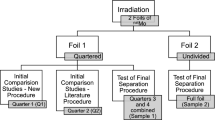Abstract.
Male Wistar rats were intraperitoneally injected with [48V]vanadium tracer to (1) investigate the distribution of vanadium over different tissues and (2) study the distribution of vanadium over the proteins and peptides in serum, packed cells and homogenates of tissues by means of liquid chromatography experiments (size exclusion, ion exchange). Target organs were primarily kidney, bone, spleen and liver. In serum we found that vanadium was mainly bound to transferrin; however, a small amount was also bound to albumin. Besides these two complexes, a significant part of vanadium occurred as readily exchangeable ("free") vanadium. In packed cells, vanadium is mainly bound to hemoglobin and to two abundant low molecular mass complexes. The chromatograms of tissues (kidney, liver, testes, spleen and lung) show similar high molecular mass complexes (vanadium co-elutes with ferritin, transferrin and hemoglobin). Between the low molecular mass complexes there are similar peaks for spleen, testes and kidneys on the one hand, and liver and lung on the other hand, albeit the differences are small. In the case of lung, there is an additional low molecular mass peak.
Similar content being viewed by others
Author information
Authors and Affiliations
Additional information
Electronic Publication
Rights and permissions
About this article
Cite this article
De Cremer, K., Van Hulle, M., Chéry, C. et al. Fractionation of vanadium complexes in serum, packed cells and tissues of Wistar rats by means of gel filtration and anion-exchange chromatography. J Biol Inorg Chem 7, 884–890 (2002). https://doi.org/10.1007/s00775-002-0376-9
Received:
Accepted:
Issue Date:
DOI: https://doi.org/10.1007/s00775-002-0376-9




